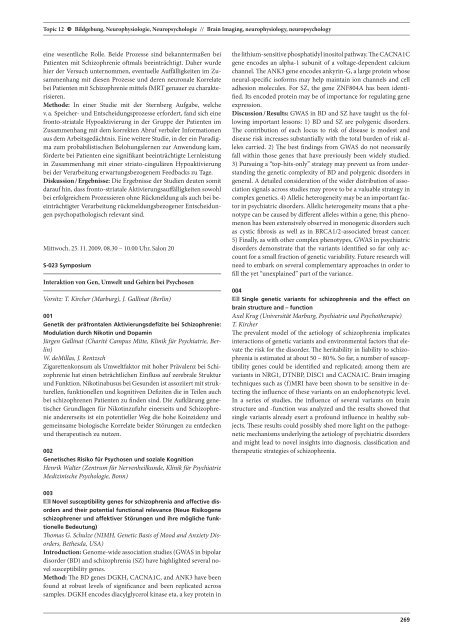Psychische Erkrankungen in der Lebensspanne ... - DGPPN
Psychische Erkrankungen in der Lebensspanne ... - DGPPN
Psychische Erkrankungen in der Lebensspanne ... - DGPPN
Erfolgreiche ePaper selbst erstellen
Machen Sie aus Ihren PDF Publikationen ein blätterbares Flipbook mit unserer einzigartigen Google optimierten e-Paper Software.
Topic 12 G Bildgebung, Neurophysiologie, Neuropsychologie // Bra<strong>in</strong> Imag<strong>in</strong>g, neurophysiology, neuropsychology<br />
e<strong>in</strong>e wesentliche Rolle. Beide Prozesse s<strong>in</strong>d bekanntermaßen bei<br />
Patienten mit Schizophrenie oftmals bee<strong>in</strong>trächtigt. Daher wurde<br />
hier <strong>der</strong> Versuch unternommen, eventuelle Auffälligkeiten im Zusammenhang<br />
mit diesen Prozesse und <strong>der</strong>en neuronale Korrelate<br />
bei Patienten mit Schizophrenie mittels fMRT genauer zu charakterisieren.<br />
Methode: In e<strong>in</strong>er Studie mit <strong>der</strong> Sternberg Aufgabe, welche<br />
v. a. Speicher- und Entscheidungsprozesse erfor<strong>der</strong>t, fand sich e<strong>in</strong>e<br />
fronto-striatale Hypoaktivierung <strong>in</strong> <strong>der</strong> Gruppe <strong>der</strong> Patienten im<br />
Zusammenhang mit dem korrekten Abruf verbaler Informationen<br />
aus dem Arbeitsgedächtnis. E<strong>in</strong>e weitere Studie, <strong>in</strong> <strong>der</strong> e<strong>in</strong> Paradigma<br />
zum probabilistischen Belohungslernen zur Anwendung kam,<br />
för<strong>der</strong>te bei Patienten e<strong>in</strong>e signifikant bee<strong>in</strong>trächtigte Lernleistung<br />
<strong>in</strong> Zusammenhang mit e<strong>in</strong>er striato-c<strong>in</strong>gulären Hypoaktivierung<br />
bei <strong>der</strong> Verarbeitung erwartungsbezogenem Feedbacks zu Tage.<br />
Diskussion / Ergebnisse: Die Ergebnisse <strong>der</strong> Studien deuten somit<br />
darauf h<strong>in</strong>, dass fronto-striatale Aktivierungsauffälligkeiten sowohl<br />
bei erfolgreichem Prozessieren ohne Rückmeldung als auch bei bee<strong>in</strong>trächtigter<br />
Verarbeitung rückmeldungsbezogener Entscheidungen<br />
psychopathologisch relevant s<strong>in</strong>d.<br />
Mittwoch, 25. 11. 2009, 08.30 – 10.00 Uhr, Salon 20<br />
S-023 Symposium<br />
Interaktion von Gen, Umwelt und Gehirn bei Psychosen<br />
Vorsitz: T. Kircher (Marburg), J. Gall<strong>in</strong>at (Berl<strong>in</strong>)<br />
001<br />
Genetik <strong>der</strong> präfrontalen Aktivierungsdefizite bei Schizophrenie:<br />
Modulation durch Nikot<strong>in</strong> und Dopam<strong>in</strong><br />
Jürgen Gall<strong>in</strong>at (Charité Campus Mitte, Kl<strong>in</strong>ik für Psychiatrie, Berl<strong>in</strong>)<br />
W. deMillas, J. Rentzsch<br />
Zigarettenkonsum als Umweltfaktor mit hoher Prävalenz bei Schizophrenie<br />
hat e<strong>in</strong>en beträchtlichen E<strong>in</strong>fluss auf zerebrale Struktur<br />
und Funktion. Nikot<strong>in</strong>abusus bei Gesunden ist assoziiert mit strukturellen,<br />
funktionellen und kognitiven Defiziten die <strong>in</strong> Teilen auch<br />
bei schizophrenen Patienten zu f<strong>in</strong>den s<strong>in</strong>d. Die Aufklärung genetischer<br />
Grundlagen für Nikot<strong>in</strong>zufuhr e<strong>in</strong>erseits und Schizophrenie<br />
an<strong>der</strong>erseits ist e<strong>in</strong> potentieller Weg die hohe Ko<strong>in</strong>zidenz und<br />
geme<strong>in</strong>same biologische Korrelate bei<strong>der</strong> Störungen zu entdecken<br />
und therapeutisch zu nutzen.<br />
002<br />
Genetisches Risiko für Psychosen und soziale Kognition<br />
Henrik Walter (Zentrum für Nervenheilkunde, Kl<strong>in</strong>ik für Psychiatrie<br />
Mediz<strong>in</strong>ische Psychologie, Bonn)<br />
003<br />
Novel susceptibility genes for schizophrenia and affective disor<strong>der</strong>s<br />
and their potential func tional relevance (Neue Risikogene<br />
schizophrener und affektiver Störungen und ihre mögliche funktionelle<br />
Bedeutung)<br />
Thomas G. Schulze (NIMH, Genetic Basis of Mood and Anxiety Disor<strong>der</strong>s,<br />
Bethesda, USA)<br />
Introduction: Genome-wide association studies (GWAS <strong>in</strong> bipolar<br />
disor<strong>der</strong> (BD) and schizophrenia (SZ) have highlighted several novel<br />
susceptibility genes.<br />
Method: The BD genes DGKH, CACNA1C, and ANK3 have been<br />
found at robust levels of significance and been replicated across<br />
samples. DGKH encodes diacylglycerol k<strong>in</strong>ase eta, a key prote<strong>in</strong> <strong>in</strong><br />
the lithium-sensitive phosphatidyl <strong>in</strong>ositol pathway. The CACNA1C<br />
gene encodes an alpha-1 subunit of a voltage-dependent calcium<br />
channel. The ANK3 gene encodes ankyr<strong>in</strong>-G, a large prote<strong>in</strong> whose<br />
neural-specific isoforms may help ma<strong>in</strong>ta<strong>in</strong> ion channels and cell<br />
adhesion molecules. For SZ, the gene ZNF804A has been identified.<br />
Its encoded prote<strong>in</strong> may be of importance for regulat<strong>in</strong>g gene<br />
expression.<br />
Discussion / Results: GWAS <strong>in</strong> BD and SZ have taught us the follow<strong>in</strong>g<br />
important lessons: 1) BD and SZ are polygenic disor<strong>der</strong>s.<br />
The contribution of each locus to risk of disease is modest and<br />
disease risk <strong>in</strong>creases substantially with the total burden of risk alleles<br />
carried. 2) The best f<strong>in</strong>d<strong>in</strong>gs from GWAS do not necessarily<br />
fall with<strong>in</strong> those genes that have previously been widely studied.<br />
3) Pursu<strong>in</strong>g a “top-hits-only” strategy may prevent us from un<strong>der</strong>stand<strong>in</strong>g<br />
the genetic complexity of BD and polygenic disor<strong>der</strong>s <strong>in</strong><br />
general. A detailed consi<strong>der</strong>ation of the wi<strong>der</strong> distribution of association<br />
signals across studies may prove to be a valuable strategy <strong>in</strong><br />
complex genetics. 4) Allelic heterogeneity may be an important factor<br />
<strong>in</strong> psychiatric disor<strong>der</strong>s. Allelic heterogeneity means that a phenotype<br />
can be caused by different alleles with<strong>in</strong> a gene; this phenomenon<br />
has been extensively observed <strong>in</strong> monogenic disor<strong>der</strong>s such<br />
as cystic fibrosis as well as <strong>in</strong> BRCA1/2-associated breast cancer.<br />
5) F<strong>in</strong>ally, as with other complex phenotypes, GWAS <strong>in</strong> psychiatric<br />
disor<strong>der</strong>s demonstrate that the variants identified so far only account<br />
for a small fraction of genetic variability. Future research will<br />
need to embark on several complementary approaches <strong>in</strong> or<strong>der</strong> to<br />
fill the yet “unexpla<strong>in</strong>ed” part of the variance.<br />
004<br />
S<strong>in</strong>gle genetic variants for schizophrenia and the effect on<br />
bra<strong>in</strong> structure and – function<br />
Axel Krug (Universität Marburg, Psychiatrie und Psychotherapie)<br />
T. Kircher<br />
The prevalent model of the aetiology of schizophrenia implicates<br />
<strong>in</strong>teractions of genetic variants and environmental factors that elevate<br />
the risk for the disor<strong>der</strong>. The heritability <strong>in</strong> liability to schizophrenia<br />
is estimated at about 50 – 80 %. So far, a number of susceptibility<br />
genes could be identified and replicated; among them are<br />
variants <strong>in</strong> NRG1, DTNBP, DISC1 and CACNA1C. Bra<strong>in</strong> imag<strong>in</strong>g<br />
techniques such as (f)MRI have been shown to be sensitive <strong>in</strong> detect<strong>in</strong>g<br />
the <strong>in</strong>fluence of these variants on an endophenotypic level.<br />
In a series of studies, the <strong>in</strong>fluence of several variants on bra<strong>in</strong><br />
structure and -function was analyzed and the results showed that<br />
s<strong>in</strong>gle variants already exert a profound <strong>in</strong>fluence <strong>in</strong> healthy subjects.<br />
These results could possibly shed more light on the pathogenetic<br />
mechanisms un<strong>der</strong>ly<strong>in</strong>g the aetiology of psychiatric disor<strong>der</strong>s<br />
and might lead to novel <strong>in</strong>sights <strong>in</strong>to diagnosis, classification and<br />
therapeutic strategies of schizophrenia.<br />
269


